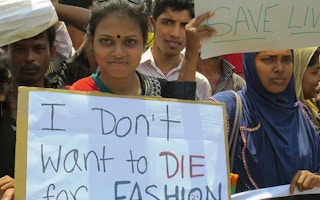Demanding more effective implementation of regulations put in place after the 2013 Rana Plaza disaster that killed more than 1,100 people, workers’ unions have called for zero tolerance to such lapses in safety.
“There can be no negotiations on worker safety and no tolerance for such accidents,” said Amirul Haque Amin, president of the National Garment Workers Federation, seven of whose members were among the over 50 injured in the factory blast.
“After Rana Plaza, the coming together of various stakeholders has brought in better regulation in the industry but casualties in such accidents are still on the higher side.”
The boiler explosion on Monday night occurred at a plant of Multifabs Limited, a Bangladeshi company on the outskirts of the capital, Dhaka.
“
Implementation of various programmes since Rana Plaza have been uneven and this accident is a reminder that there has to be greater capacity building on ground.
Raisul Islam Khan, UNI Global Union
The firm supplies knitted apparel to clients in Sweden, Denmark, Germany, Russia, Spain, Netherlands and Britain, including to Littlewoods, one of Britain’s oldest retail brands.
The company said the plant was functioning well and the boiler, procured from Germany, had just been serviced. The factory had been shut for 10 days for the Eid period at the end of the Muslim holy month of Ramadan and was being readied to resume operations from Tuesday.
The company had undergone mandatory independent safety inspections as it supplies to brands that are signatories to the Bangladesh Accord on fire and building safety, an independent, legally binding framework set up after the Rana Plaza collapse.
Bangladesh’s garment-making industry, the biggest in the world after China’s, came under scrutiny after the collapse of the eight-storey Rana Plaza factory complex and a fire at a garment factory in 2012 that killed 112 workers.
“Implementation of various programmes since Rana Plaza have been uneven and this accident is a reminder that there has to be greater capacity building on ground,” said Raisul Islam Khan of UNI Global Union, a federation of trade unions.
Bangladesh’s labour department needs to be strengthened, labour inspectors better qualified and more local initiatives are needed to plug the gaps, he told the Thomson Reuters Foundation.
Campaigners say the progress in fixing problems in the supply chain has been slow in the industry that employs 4 million people and generates 80 percent of Bangladesh’s export earnings.
They have criticised many retailers for failing to improve working conditions - with long hours, low pay, poor safety standards and not being allowed to form trade unions common complaints from garment workers.
“The accident shows that the process started after Rana Plaza is far from over and reforms need to be expedited,” said Amin.
This story was published with permission from Thomson Reuters Foundation, the charitable arm of Thomson Reuters, that covers humanitarian news, women’s rights, trafficking and climate change. Visit www.trust.org.










